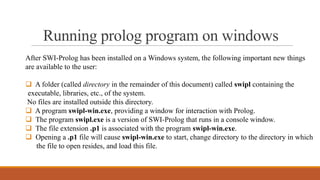Prolog Programming : Basics
- 1. Prolog Programming BY: MITUL K. DESAI
- 2. What is Prolog? Prolog stands for programming in logic (PROgrammation en LOgique). Prolog is the most widely used language to have been inspired by logic programming research. Prolog is the only successful example of the family of logic programming languages. A Prolog program is a theory written in a subset of first-order logic, called Horn clause logic. Prolog is declarative. A Prolog programmer concentrates on what the program needs to do, not on how to do it.
- 3. A Little History Prolog was invented by Alain Colmerauer, a professor of computer science at the university of Aix-Marseille in France, in 1972. The first application of Prolog was in natural language processing. Its theoretical underpinning are due to Donald Loveland of Duke university through Robert Kowalski (formerly) of the university of Edinburgh
- 4. Main Advantages Ease of representing knowledge. Natural support of pattern-matching. Natural support of meta-programming. Meaning of programs is independent of how they are executed. Simple connection between programs and computed answers and specifications. No need to distinguish programs from databases.
- 5. Anatomy of Prolog Program Prolog programs are made up of facts and rules. A fact asserts some property of an object, or relation between two or more objects. e.g. parent(jane,alan). Can be read as “Jane is the parent of Alan.” Rules allow us to infer that a property or relationship holds based on preconditions. e.g. parent(X,Y) :- mother(X,Y). = “Person X is the parent of person Y if X is Y‟s mother.”
- 6. Predicate Definitions Both facts and rules are predicate definitions. ‘Predicate’is the name given to the word occurring before the bracket in a fact or rule: parent (jane,alan). By defining a predicate you are specifying which information needs to be known for the property denoted by the predicate to be true. Predicate name
- 7. Clauses Predicate definitions consist of clauses. = An individual definition (whether it be a fact or rule). e.g. mother(jane, alan). = Fact parent(P1,P2):- mother(P1,P2). = Rule A clause consists of a head And sometimes a body. -- Facts don‟t have a body because they are always true. head body
- 8. Arguments A predicate head consists of a predicate name and sometimes some arguments contained within brackets and separated by commas. mother(jane, alan). A body can be made up of any number of subgoals (calls to other predicates) and terms. Arguments also consist of terms, which can be: -- Constants e.g. jane, -- Variables e.g. Person1, or -- Compound terms Predicate name Arguments
- 9. Terms: Constants Constants can either be: Numbers: integers are the usual form (e.g. 1, 0, -1, etc), but floating-point numbers can also be used (e.g. 3.0E7) Symbolic constants: always start with a lower case alphabetic character and contain any mixture of letters, digits, and underscores (but no spaces, punctuation, or an initial capital). e.g. abc, big_long_constant, x4_3t. String constants: are anything between single quotes e.g. „Like this‟.
- 10. Terms: Variables Variables always start with an upper case alphabetic character or an underscore. Other than the first character they can be made up of any mixture of letters, digits, and underscores. e.g. X, ABC, _89two5, _very_long_variable There are no “types” for variables (or constants) – a variable can take any value. All Prolog variables have a “local” scope: --- they only keep the same value within a clause; the same variable used outside of a clause does not inherit the value (this would be a “global” scope).
- 11. Naming Tips Use real English when naming predicates, constants, and variables. e.g. “John wants to help Somebody.” Could be: wants(john, to_help, Somebody). Not: x87g(j,_789). Use a Verb Subject Object structure: wants(john, to_help). BUT do not assume Prolog Understands the meaning of your chosen names! -- You create meaning by specifying the body (i.e. preconditions) of a clause.
- 12. Using Predicate Definitions Command line programming is tedious e.g. | ?- write(„What is your name?‟), nl, read(X), write(„Hello „), write(X). We can define predicates to automate commands: | ?- greetings. What is your name? |: tim. Hello tim X = tim ? yes Prolog Code Terminal greetings:- write(‘What is your name?’), nl, read(X), write(‘Hello ‘), write(X).
- 13. Running prolog program on windows After SWI-Prolog has been installed on a Windows system, the following important new things are available to the user: A folder (called directory in the remainder of this document) called swipl containing the executable, libraries, etc., of the system. No files are installed outside this directory. A program swipl-win.exe, providing a window for interaction with Prolog. The program swipl.exe is a version of SWI-Prolog that runs in a console window. The file extension .p1 is associated with the program swipl-win.exe. Opening a .p1 file will cause swipl-win.exe to start, change directory to the directory in which the file to open resides, and load this file.
- 14. Executing a query After loading a program, one can ask Prolog queries about the program. ?- likes (sam, x) . X = dahl ; X = tandoori ; …… X = chips ; ?-
- 15. Prolog Execution Most Prolog clauses have both a declarative reading and a procedural reading. Whenever possible, the declarative reading is to be preferred. mother (X, Y) :- parent (X, Y), female (X) . Declarative reading: x is the mother of y if x is parent of y and x is female
- 16. Prolog Execution Procedural reading : To show that x is the mother of y, first show that x is a parent of y, then show that x is female. Clauses: parent (john, bill) . parent (jane, bill) . female(jane) . Query: | ?- mother (M, bill) .
- 17. Prolog Execution The clause of mother /2 will be located, and the unification X=M, Y=bill will occur. Then parent (M, bill) will be attempted, resulting in the unification M=john. Next, female (john) will be attempted, but will fail. Prolog will backtrack to parent (M, bill) and look for another solution for this; it will succeed and unify M=jane. Finally, it will attempt female (jane), and succeed; so the inquiry will succeed, having performed the unification M=jane.
- 18. Thank You


















